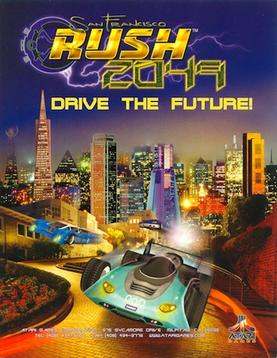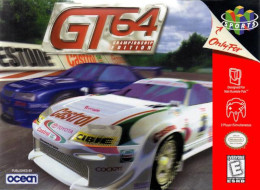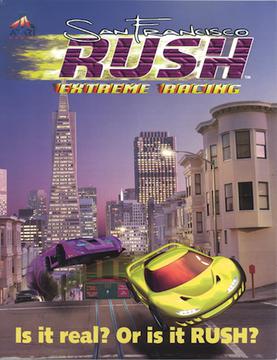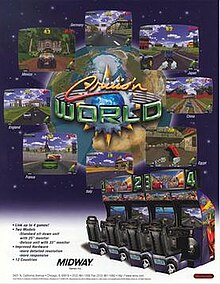
The Nintendo 64 (N64) is a home video game console developed by Nintendo. It was released on June 23, 1996, in Japan; on September 29, 1996, in North America; and on March 1, 1997, in Europe and Australia. The successor to the Super Nintendo Entertainment System, it was the last major home console to use cartridges as its primary storage format until the Nintendo Switch in 2017. As a fifth-generation console, the Nintendo 64 primarily competed with the Sony PlayStation and the Sega Saturn.

Mario Kart 64 is a kart racing video game developed and published by Nintendo for the Nintendo 64 (N64). It is the second main entry in the Mario Kart series and is the successor to Super Mario Kart (1992) for the Super Nintendo Entertainment System. It was released in Japan on December 14, 1996; in North America on February 10, 1997; in the United Kingdom on June 13, 1997; and in Europe on June 24, 1997. It was released for the iQue Player in China on December 25, 2003. It was released on the Wii and Wii U Virtual Console in 2007 and 2016, and on the Nintendo Switch Online + Expansion Pack on October 25, 2021.

Cruis'n USA is an arcade racing game originally released in 1994. It was developed by Eugene Jarvis' company TV Games Inc., and manufactured by Midway Games. It is the first game in the Cruis'n series and features races set in locations across the continental United States.

Cruis'n Exotica is a 1999 racing game developed for arcades by Midway Games. The game is a sequel to Cruis'n World and is the third entry in the Cruis'n series.

San Francisco Rush 2049 is a racing video game developed and manufactured by Atari Games for arcades. It was ported to the Nintendo 64, Game Boy Color, and Dreamcast by Midway Games West. The arcade machine was released in 1999; home versions followed in 2000 on September 7 for North America and November 17 for Europe. It is the third game in the Rush series and the sequel to San Francisco Rush: Extreme Racing and Rush 2: Extreme Racing USA. It is the last game in the Rush series to be set in the city of San Francisco and the last released on a Nintendo console. It also serves as the final game for the Atari Games label, which was retired shortly after the arcade release. The Dreamcast version was later re-released as part of Midway Arcade Treasures 3 for the PlayStation 2, Xbox, and GameCube and later for Microsoft Windows as part of Midway Arcade Treasures Deluxe Edition.

Ridge Racer 64 is a racing video game developed by Nintendo Software Technology for the Nintendo 64 in 2000. It features a total of 20 race tracks, including some drawn from Ridge Racer and Ridge Racer Revolution.

Vigilante 8 is a vehicular combat video game developed by Luxoflux and published by Activision for PlayStation, Nintendo 64, and Game Boy Color. Although officially it has no connection to the Interstate '76 series, it features several of its themes.

War Gods is a fighting video game originally released to arcades by Midway Games in 1996. Ports for the Nintendo 64, PlayStation and Windows were released in 1997. In the game, players control one of ten fighters who have been given great power by a mysterious ore that crashed-landed on Earth from outer space. The object of the game is to defeat all the other fighters to become the most powerful warrior on the planet.

Top Gear Rally is a 1997 racing video game developed by Boss Game Studios and released for the Nintendo 64. A follow-up to Kemco's original Top Gear game, it features a championship mode where a single player must complete six seasons of two to four races, as well as a multiplayer mode where two players may compete against each other via a split-screen display. The game's tracks combine both road and off-road surfaces and can be played in different weather conditions, including night, fog, rain, and snow. Players may customize their car with different tire grips and adjust its suspension stiffness and steering sensitivity. An option that allows players to custom paint their cars is also included.

Rampage World Tour is an arcade video game released by Midway in 1997 as the sequel to Rampage. It was developed at Game Refuge by Brian Colin and Jeff Nauman, who designed the 1986 original. Ports were released for the Sega Saturn, Nintendo 64, Game Boy Color, PlayStation, and Microsoft Windows. It was re-released on Midway Arcade Treasures 2 and included in Rampage: Total Destruction.

NBA Showtime is a basketball arcade game released by Midway in 1999, featuring teams and players from the National Basketball Association (NBA). The game is modeled after the NBA presentations on NBC and takes its name from NBC's NBA pregame show. It is the successor to Midway's previous basketball titles NBA Hangtime and NBA Jam and is the first in the series to have fully 3-D polygonal graphics, featuring real uniforms for all teams. Showtime was also featured in a dual game cabinet along with NFL Blitz 2000 that Midway dubbed the "SportStation." Midway followed up the game with the console exclusive NBA Hoopz.

MRC: Multi-Racing Championship, also known as simply Multi Racing Championship, is a racing video game developed by Genki and released for the Nintendo 64 in 1997. It was published in North America and Europe by Ocean and in Japan by Imagineer. The game is compatible with the Controller Pak and the Rumble Pak.

S.C.A.R.S. is a racing video game developed by Vivid Image and published by Ubi Soft for PlayStation, Nintendo 64, and Microsoft Windows in 1998.

Hydro Thunder is an arcade inshore powerboat racing video game originally released by Midway Games in February 1999 and later released for the Sega Dreamcast as a launch title later that year. It was also released for the PlayStation and Nintendo 64 in early 2000. This game is part of Midway's Thunder series of racing games, which includes Offroad Thunder, 4 Wheel Thunder, and Arctic Thunder. Hydro Thunder Hurricane, a sequel to Hydro Thunder, was later released for the Xbox 360 on July 27, 2010 on Xbox Live Arcade.

California Speed is a racing video game developed and published by Atari Games. The game was first released in arcades in 1998 and was ported to the Nintendo 64 in 1999 by Midway. The Nintendo 64 version of the game contains support for the Controller Pak and the Rumble Pak.

GT 64: Championship Edition, known as City Tour GrandPrix: Zen Nihon GT Senshuken in Japan, is a racing video game developed by Imagineer and released for the Nintendo 64 console in 1998. It is an official licensed game to All-Japan GT Championship, featuring cars and drivers of the 1997 All Japan Grand Touring Car Championship.

Off Road Challenge is a video game developed and published by Midway. The game was originally released in 1997 for arcades using the Midway V Unit hardware. It is part of the Off Road series which began with Ivan 'Ironman' Stewart's Super Off Road.

Cruis'n is a series of racing video games originally developed by Eugene Jarvis for Midway Games and published by Midway and Nintendo. The series distinguishes itself from other racing games with its over-the-top presentation and fast-paced gameplay, featuring a wide variety of vehicles and tracks based on a variety of real world locations. The series debuted in North American and European arcades in 1994 with the release of Cruis'n USA, which, along with Killer Instinct, was advertised as running on Nintendo's Ultra 64 hardware. Two sequels followed, Cruis'n World and Cruis'n Exotica, which featured new vehicles and tracks. All three games were released for the Nintendo 64 as well, with Exotica also being released for the handheld Game Boy Color. The next game in the series, Cruis'n Velocity deviated from the traditional arcade gameplay of the series and was released for the Game Boy Advance.

San Francisco Rush: Extreme Racing is a video game developed and published by Atari Games. This game was first released in arcades in 1996 and was ported to Nintendo 64 in 1997 and the PlayStation in 1998. San Francisco Rush: Extreme Racing is the first game in the Rush series.

NFL Blitz is an American football video game developed and published by Midway for the arcade in 1997, the first game in the NFL Blitz series. The development team was headed by Mark Turmell and Sal Divita, who were known for being behind NBA Jam, and NFL Blitz was a deliberate attempt to translate the exaggerated arcade-style approach of NBA Jam to the football realm. The game was ported to the PlayStation, Nintendo 64, Windows, and Game Boy Color in 1998. The cover athlete for the game was then Pittsburgh Steelers quarterback Kordell Stewart.





















